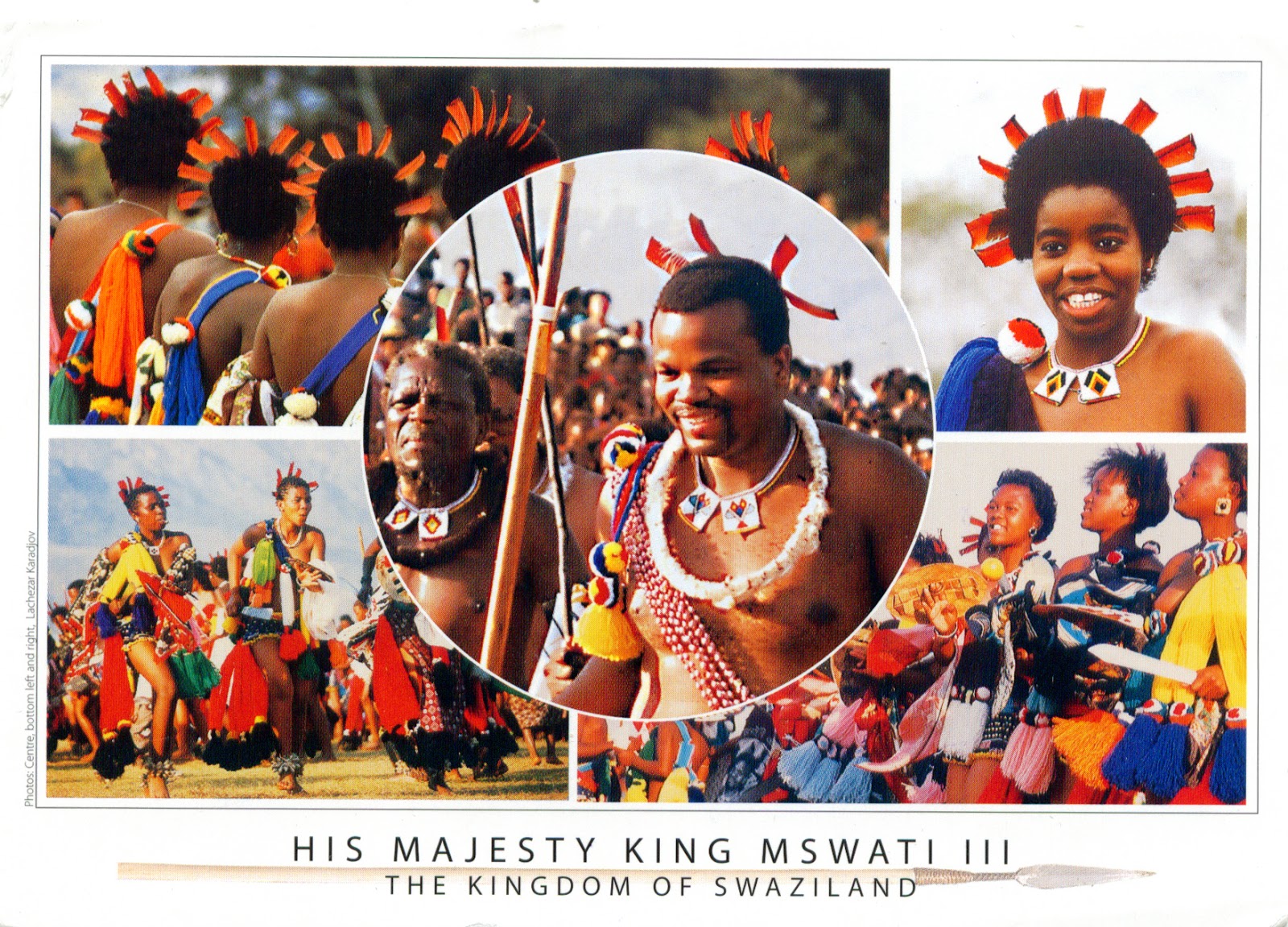 |
| 1144 King Mswati III and the Reed Dance |
The Swazi are a Bantu Nguni-speaking people in southeastern Africa, chiefly in Swaziland and South Africa. The term bakaNgwane (Ngwane's people) is still used as an alternative to emaSwati, to refer to the Swazi people. They originated in South-east Africa in the 15th century, moved into southern Mozambique, and then into present-day Swaziland (sometimes called kaNgwane or Eswatini), a small, land-locked country, bordered by South Africa and by Mozambique. The first king of modern Swaziland was Ngwane III (1745-1780). In the 1840s, a substantial portion of Swazi territory was ceded to the Transvaal Boers, instead the remaining territory of Swaziland, and their king, Mswati II, were recognized by both the Transvaal and by Britain. The Pretoria Convention for the Settlement of the Transvaal in 1881 recognized the independence of Swaziland and defined its boundaries. Britain claimed authority over Swaziland in 1903, and independence was regained in 1968. Today, the number of Swazis in South Africa is slight larger than that of Swazis in Swaziland, which is approximately 1.1 million people.
The country is a monarchy, currently ruled by King (Ngwenyama) Mswati III (in the center of the postcard), the head of the House of Dlamini, which traces itself back to a chief Dlamini I (also known as Matalatala), who is said to have migrated with the Swazi people from East Africa through Tanzania and Mozambique. Swazi kings up to the present day are referred to as Ingwenyama and they rule together with the Queen Mother who is called Indlovukati. The royal family includes, but is not strictly limited to, the king, the queen mother, the king's wives (Emakhosikati), the kings children, as well as the king's siblings, the king's half-siblings and their families. Due to the practice of polygamy, the number of people who can be counted as members of the royal family is relatively large. For example, Mswati III is thought to have over 200 brothers and sister.
Mswati III (born Prince Makhosetive Dlamini on 19 April 1968) was the son of King Sobhuza II and of one of his younger wives Ntfombi Tfwala. He then attended from 1983 to 1986 Sherborne School in north-west Dorset, England, and was crowned on April 25, 1986 at the age of 18, thus becoming the youngest ruling monarch at the time in the world. The king and his mother, whose title is Indlovukati (Great She-Elephant), rule jointly. Today he is Africa's last absolute monarch in the sense that he has the power to choose the prime minister, other top government posts and top traditional posts. In 2004, Mswati promulgated a new constitution that allows freedom of speech and assembly for the media and public, while retaining the traditional Tinkhundla system. Mswati III is known for his practice of polygyny and currently has 15 wives and 27 children.
Old Swazi traditions are carefully guarded and colourful ceremonies regularly take place to mark special occasions. The most important traditional dances and ceremonies are Umhlanga / Reed Dance, Incwala Ceremony, Lutsango Reed Dance, and Sibhaca Dance. The Reed Dance (in the postcard) takes place late August or early September, and is one of the most colourful ceremonies in the whole of Africa. It attracts young maidens from all over the Kingdom, who gather reeds from selected areas and travel to the Royal Kraal to honour the Queen Mother. It is from this custom that the ceremony derived its name. The maidens dress in short beaded skirts, colourful sashes, ankles, and bracelets. Each sash has appendages of different coloured wool streamers; these denote whether or not the maiden is bethrothhed (promised to marry). The royal princesses wear red feathers in their hair and lead the maidens to perform traditional dances before their Majesties, i.e. the climax of the event.
About the stamps
The first stamp is part of a large series of 12 stamps with butterflies, issued in 1992. The second is part of the series of 6 stamps with the subject Towards 2022, issued on 2013.
References
Swaziland -Wikipedia
Mswati III - Wikipedia
King of Swaziland - Mswati III - kingofswaziland.com
Traditional Ceremonies and Dances - Swaziland High Commission Malaysia
The Umhlanga Or Reed Dance - Swaziland National Trust Commission
sender: Mandlakhe
sent from ??? (??? / Swaziland), on 10.06.2014
photo: Dirk Schwager

No comments:
Post a Comment